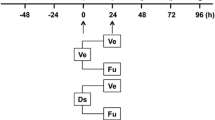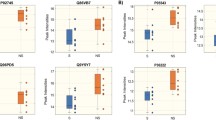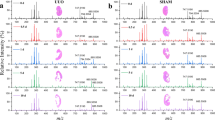Abstract
Hemorrhagic shock, often a result of traumatic injury, is a condition of reduced perfusion that results in diminished delivery of oxygen to tissues. The disruption in oxygen delivery induced by both ischemia (diminished oxygen delivery) and reperfusion (restoration of oxygen delivery) has profound consequences for cellular metabolism and the maintenance of homeostasis. The pathophysiologic state associated with traumatic injury and hemorrhagic shock was studied with a scale-invariant metabolic network. Urinary metabolic profiles were constructed from NMR spectra of urine samples collected at set timepoints in a porcine model of hemorrhagic shock that included a pulmonary contusion, a liver crush injury, and a 35 % controlled bleed. The network was constructed from these metabolic profiles. A partial least squares discriminant analysis (PLS-DA) model that discriminates by experimental timepoint was also constructed. Comparisons of the network (functional relationships among metabolites) and PLS-DA model (observable relationships to experimental time course) revealed complementary information. First, ischemia/reperfusion injury and evidence of cell death due to hemorrhage was associated with early resuscitation timepoints. Second, evidence of increased protein catabolism and traumatic injury was associated with late resuscitation timepoints. These results are concordant with generally accepted views of the metabolic progression of shock.






Similar content being viewed by others
References
Angele, M. K., Schneider, C. P., & Chaudry, I. H. (2008). Bench-to-bedside review: Latest results in hemorrhagic shock. Critical Care, 12, 218.
Aon, M. A., Cortassa, S., & O’Rourke, B. (2007). On the network properties of mitochondria. In V. Saks (Ed.), Molecular system bioenergetics: Energy for life (pp. 111–135). Weinheim: Wiley-VCH.
Barabási, A. L., & Oltvai, Z. N. (2004). Network biology: Understanding the cell’s functional organization. Nature Reviews Genetics, 5, 101–113.
Cohen, M. J., Serkova, N. J., Wiener-Kronish, J., Pittet, J. F., & Niemann, C. U. (2010). 1H-NMR-based metabolic signatures of clinical outcomes in trauma patients-beyond lactate and base deficit. J Trauma, 69, 31–40.
Cuthbertson, D. (1942). Post-shock metabolic response. The Lancet, 239, 433–437.
Eastridge, B, & Cohn, S. (2011). Military and civilian joint research gaps. Resource document. National Institute of Trauma. http://www.nationaltraumainstitute.org/news_and_information/white_papers_and_presentations.html. Accessed 1 November 2011.
Fiehn, O. (2002). Metabolomics—the link between genotypes and phenotypes. Plant Molecular Biology, 48, 155–171.
Fink, M. P. (2002). Bench-to-bedside review: Cytopathic hypoxia. Critical Care, 6, 491–499.
Hill, A., & Hill, G. (1998). Metabolic response to severe injury. British Journal of Surgery, 85, 884–890.
Holcomb, J. B., Pusateri, A. E., Harris, R. A., et al. (1999). Effect of dry fibrin sealant dressings versus gauze packing on blood loss in grade V liver injuries in resuscitated swine. J Trauma, 46, 49.
Holcomb, J. B., Stansbury, L. G., Champion, H. R., Wade, C., & Bellamy, R. F. (2006). Understanding combat casualty care statistics. J Trauma, 60, 397.
Hu, Z., Mellor, J., Wu, J., & DeLisi, C. (2004). VisANT: An online visualization and analysis tool for biological interaction data. BMC Bioinformatics, 5, 17.
Jeevanandam, M., Young, D. H., Ramias, L., & Schiller, W. R. (1989). Aminoaciduria of severe trauma. American Journal of Clinical Nutrition, 49, 814.
Kinross, J. M., Alkhamesi, N., Barton, R. H., et al. (2011). Global metabolic phenotyping in an experimental laparotomy model of surgical trauma. Journal of Proteome Research, 10(1), 277–287.
Klein, J. (2000). Membrane breakdown in acute and chronic neurodegeneration: Focus on choline-containing phospholipids. Journal of Neural Transmission, 107, 1027–1063.
Langfelder, P., & Horvath, S. (2008). WGCNA: An R package for weighted correlation network analysis. BMC Bioinformatics, 9, 559.
Langfelder, P., Zhang, B., & Horvath, S. (2008). Defining clusters from a hierarchical cluster tree: The dynamic tree cut package for R. Bioinformatics, 24, 719.
Lee, J., Lee, H., & Sadler, P. (1991). Uraemia: Is urea more important than we think? The Lancet, 338, 1438–1440.
Lipton, P. (1999). Ischemic cell death in brain neurons. Physiological Reviews, 79, 1431–1568.
Lusczek, E. R., Nelson, T., Lexcen, D., Witowski, N. E., Mulier, K. E., & Beilman, G. (2011). Urine metabolomics in hemorrhagic shock: Normalization of urine in the face of changing intravascular fluid volume and perturbations in metabolism. Journal of Bioanalysis & Biomedicine, 3, 038–048.
Mortishire-Smith, R. J., Skiles, G. L., Lawrence, J. W., et al. (2004). Use of metabonomics to identify impaired fatty acid metabolism as the mechanism of a drug-induced toxicity. Chemical Research in Toxicology, 17, 165–173.
Mulier, K. E., Greenberg, J. G., & Beilman, G. J. (2011). Hypercoagulability in porcine hemorrhagic shock is present early after trauma and resuscitation. J Surg Res, 174, e31–e35.
Nicholson, J. K., Lindon, J. C., & Holmes, E. (1999). ‘Metabonomics’: Understanding the metabolic responses of living systems to pathophysiological stimuli via multivariate statistical analysis of biological NMR spectroscopic data. Xenobiotica, 29, 1181–1189.
Peitzman, A. B., Harbrecht, B. G., Udekwu, A. O., Billiar, T. R., Kelly, E., & Simmons, R. L. (1995). Hemorrhagic shock. Current Problems in Surgery, 32, 925–1002.
R Team. (2010). R: A language and environment for statistical computing. Vienna, Austria: R Foundation for Statistical Computing.
Ravasz, E., Somera, A. L., Mongru, D. A., Oltvai, Z. N., & Barabási, A. L. (2002). Hierarchical organization of modularity in metabolic networks. Science, 297, 1551.
Sack, M. (2006). Mitochondrial depolarization and the role of uncoupling proteins in ischemia tolerance. Cardiovascular Research, 72, 210–219.
Simenhoff, M. L., Saukkonen, J. J., Burke, J. F., et al. (1978). Importance of aliphatic amines in uremia. Kidney International. Supplement, 8, S16–S19.
Somero, G. N. (1986). From dogfish to dogs: Trimethylamines protect proteins from urea. Physiology, 1, 9–12.
Threlfall, C. J., Maxwell, A. R., & Stoner, H. B. (1984). Post-traumatic creatinuria. J Trauma, 24, 516.
Vaidya, V. S., Ferguson, M. A., & Bonventre, J. V. (2008). Biomarkers of acute kidney injury. Annual Review of Pharmacology and Toxicology, 48, 463.
Weljie, A. M., Newton, J., Mercier, P., Carlson, E., & Slupsky, C. M. (2006). Targeted profiling: Quantitative analysis of 1H NMR metabolomics data. Analytical Chemistry, 78, 4430–4442.
West, G. B., Woodruff, W. H., & Brown, J. H. (2002). Allometric scaling of metabolic rate from molecules and mitochondria to cells and mammals. Proceedings of the National Academy of Sciences, 99, 2473.
Wishart, D. S. (2006). Metabolomics in monitoring kidney transplants. Current Opinion in Nephrology and Hypertension, 15, 637.
Wold, S., Sjostrom, M., & Eriksson, L. (2001). PLS-regression: A basic tool of chemometrics. Chemometrics and Intelligent Laboratory Systems, 58, 109–130.
Xiao, W., Mindrinos, M. N., Seok, J., et al. (2011). A genomic storm in critically injured humans. J. Exp. Med., 208, 2581–2590.
Zhao, W., Langfelder, P., Fuller, T., Dong, J., Li, A., & Hovarth, S. (2010). Weighted gene coexpression network analysis: State of the art. Journal of Biopharmaceutical Statistics, 20, 281–300.
Acknowledgments
The authors wish to thank the Office of Naval Research for their continued funding of this research (grants N00014-09-1-0323 and N000-05-1-0344), the Minnesota Supercomputing Institute, the University of Minnesota’s Nuclear Magnetic Resonance Facility (funding provided by NSF grant BIR-961477, the University of Minnesota Medical School, and the Minnesota Medical Foundation), and the University of Minnesota. The authors also wish to thank Dr. Susan Jones for her helpful feedback in the preparation of this manuscript.
Author information
Authors and Affiliations
Corresponding author
Electronic supplementary material
Below is the link to the electronic supplementary material.





Rights and permissions
About this article
Cite this article
Lusczek, E.R., Lexcen, D.R., Witowski, N.E. et al. Urinary metabolic network analysis in trauma, hemorrhagic shock, and resuscitation. Metabolomics 9, 223–235 (2013). https://doi.org/10.1007/s11306-012-0441-5
Received:
Accepted:
Published:
Issue Date:
DOI: https://doi.org/10.1007/s11306-012-0441-5




